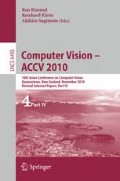Abstract
Local feature-based object recognition methods recognize learned objects by unordered local feature matching followed by verification. However, the matching between unordered feature sets might be ambiguous as the number of objects increases, because multiple similar features can be observed in different objects. In this context, we present a new method for textured object recognition based on relational information between local features. To efficiently reduce ambiguity, we represent objects using the Attributed Relational Graph. Robust object recognition is achieved by the inexact graph matching. Here, we propose a new method for building graphs and define robust attributes for nodes and edges of the graph, which are the most important factors in the graph-based object representation, and also propose a cost function for graph matching. Dependent on the proposed attributes, the proposed framework can be applied to both single-image-based and stereo-image-based object recognition.
Access this chapter
Tax calculation will be finalised at checkout
Purchases are for personal use only
Preview
Unable to display preview. Download preview PDF.
References
Lindeberg, T.: Detecting salient blob-like image structures and their scales with a scale-space primal sketch: a method for focus-of-attention. International Journal of Computer Vision 11, 283–318 (1993)
Shokoufandeh, A., Marsic, I., Dickinson, S.: View-based object matching. In: IEEE International Conference on Computer Vision, pp. 588–595 (1998)
Schmid, C., Bauckhage, R.M.: Evaluation of interest point detectors. International Journal of Computer Vision 37, 151–172 (2000)
Mikolajczyk, K., Schmid, C.: Scale & affine invariant interest point detectors. International Journal of Computer Vision 60, 63–86 (2004)
Ke, Y., Sukthankar, R.: Pca-sift: a more distinctive representation for local image descriptors. In: IEEE Conference on Computer Vision and Pattern Recognition, pp. 506–513 (2004)
Kim, S., Yoon, K.J., Kweon, I.S.: Object recognition using a generalized robust invariant feature and gestalt’s law of proximity and similarity. Pattern Recognition 41, 726–741 (2008)
Lowe, D.G.: Distinctive image features from scale-invariant keypoints. International Journal of Computer Vision 60, 91–110 (2004)
Mikolajczyk, K., Schmid, C.: A performance evaluation of local descriptors. IEEE Transactions on Pattern Analysis and Machine Intelligence 27, 1615–1630 (2005)
Tico, M., Kuosmanen, P.: Fingerpoint matching using an orientation-based minutia descriptor. IEEE Transactions on Pattern Analysis and Machine Intelligence 25, 1009–1014 (2003)
Schmid, C.: A structured probabilistic model for recognition. In: IEEE Conference on Computer Vision and Pattern Recognition, pp. 485–490 (1999)
Fergus, R., Perona, P., Zisserman, A.: Object class recognition by unsupervised scale-invariant learning. In: IEEE Conference on Computer Vision and Pattern Recognition, pp. 264–271 (2003)
Moreels, P., Maire, M., Perona, P.: Recognition by probabilistic hypothesis construction. In: Eurographics Symposium on Rendering, pp. 55–68 (2004)
Ballard, D.H.: Generalizing the hough transform to detect arbitrary shapes. Pattern Recognition 13, 111–122 (1981)
Lamdan, Y., Wolfson, H.J.: Geometric hashing: A general and efficient model-based recognition scheme. In: International Conference on Computer Vision, pp. 238–249 (1988)
Dorkó, G., Schmid, C.: Selection of scale-invariant parts for object class recognition. In: International Conference on Computer Vision, pp. 634–639 (2003)
Sivic, J., Russell, B.C., Efros, A.A., Zisserman, A., Freeman, W.T.: Discovering object categories in image collections. In: International Conference on Computer Vision (2005)
Felzenszwalb, P.F., Huttenlocher, D.P.: Pictorial structure for object recognition. International Journal of Computer Vision 61, 55–79 (2005)
Crandall, D., Felzenszwalb, P., Huttenlocher, D.: Spatial priors for part-based recognition using statistical models. In: IEEE Conference on Computer Vision and Pattern Recognition, pp. 10–17 (2005)
Gold, S., Rangarajan, A.: A graduated assignment algorithm for graph matching. IEEE Transactions on Pattern Analysis and Machine Intelligence 18, 377–388 (1996)
Caetano, T.S., Cheng, L., Le, Q.V., Smola, A.J.: Learning graph matching. In: IEEE International Conference on Computer Vision, pp. 1–8 (2007)
Torresani, L., Kolmogorov, V., Rother, C.: Feature correspondence via graph matching: Models and global optimization. In: Forsyth, D., Torr, P., Zisserman, A. (eds.) ECCV 2008, Part II. LNCS, vol. 5303, pp. 596–609. Springer, Heidelberg (2008)
Graciano, A., Cesar Jr., R., Bloch, I.: Graph-based object tracking using structural pattern recognition. In: Proc. of SIBGRAPI, pp. 179–186 (2007)
Carneiro, G., Jepson, A.D.: Object recognition using flexible groups of local features. Technical Report CSRG-481 (2004)
Conte, D., Foggia, P., Sansone, C., Vento, M.: How and why pattern recognition and computer vision applications use graph. Springer, New York (2007)
Guerra Filho, G.: Disambiguating the recognition of 3d objects. In: IEEE Conference on Computer Vision and Pattern Recognition, pp. 2278–2285 (2009)
Leung, T., Malik, J.: Representing and recognizing the visual appearance of materials using three-dimensional textons. International Journal of Computer Vision 43, 29–44 (2001)
Author information
Authors and Affiliations
Editor information
Editors and Affiliations
Rights and permissions
Copyright information
© 2011 Springer-Verlag Berlin Heidelberg
About this paper
Cite this paper
Yoon, KJ., Shin, MG. (2011). Reducing Ambiguity in Object Recognition Using Relational Information. In: Kimmel, R., Klette, R., Sugimoto, A. (eds) Computer Vision – ACCV 2010. ACCV 2010. Lecture Notes in Computer Science, vol 6495. Springer, Berlin, Heidelberg. https://doi.org/10.1007/978-3-642-19282-1_24
Download citation
DOI: https://doi.org/10.1007/978-3-642-19282-1_24
Publisher Name: Springer, Berlin, Heidelberg
Print ISBN: 978-3-642-19281-4
Online ISBN: 978-3-642-19282-1
eBook Packages: Computer ScienceComputer Science (R0)

